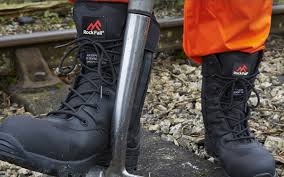The Importance of Protective Footwear
Protective footwear plays a crucial role in ensuring the safety and well-being of workers in various industries. Whether you work in construction, manufacturing, healthcare, or any other field that involves potential hazards, wearing the right protective footwear is essential.
One of the primary functions of protective footwear is to prevent injuries from sharp objects, heavy items, electrical hazards, slippery surfaces, and other workplace dangers. By providing a barrier between your feet and potential risks, protective footwear can significantly reduce the risk of accidents and injuries.
Additionally, protective footwear is designed to offer support and stability to your feet and ankles, helping to prevent strains, sprains, and other musculoskeletal injuries. Properly fitted protective footwear can also improve comfort during long hours on your feet, enhancing overall productivity and well-being.
When choosing protective footwear, it’s important to consider the specific hazards present in your work environment. Different types of protective footwear are available to address various risks, including steel-toe boots for impact protection, slip-resistant shoes for slippery surfaces, and insulated boots for thermal protection.
Employers have a responsibility to provide suitable protective footwear to their employees based on the nature of their work. Workers should also take responsibility for wearing their protective footwear correctly and ensuring that it is well-maintained and replaced when necessary.
Ultimately, investing in high-quality protective footwear is an investment in safety. By prioritising the use of appropriate protective footwear in the workplace, both employers and employees can create a safer working environment and reduce the likelihood of accidents and injuries.
The Classification of Protective Footwear as Personal Protective Equipment (PPE)
The Importance of Wearing Protective Footwear in Hazardous Environments
4. Defining the Range of
- What is protective footwear for welding?
- Is protective footwear a PPE?
- Why wear protective footwear?
- What is considered protective footwear?
What is protective footwear for welding?
Protective footwear for welding is specially designed to provide essential protection for welders working in environments with potential hazards such as sparks, molten metal, and heat. Welding boots typically feature heat-resistant materials that can withstand high temperatures and prevent burns or injuries from hot metal splashes. Additionally, these boots often have reinforced toes to protect against impact and compression injuries that may occur while working with heavy equipment or materials. The non-slip soles of welding footwear help prevent slips and falls on slippery surfaces, ensuring stability and safety for welders in their work environment. Choosing the right protective footwear for welding is crucial to ensure the well-being and safety of welders during their tasks.
Is protective footwear a PPE?
Protective footwear is classified as Personal Protective Equipment (PPE) under health and safety regulations. PPE is defined as equipment designed to protect the wearer against health and safety risks at work. In the case of protective footwear, it serves as a crucial form of PPE that helps prevent foot injuries and provide support in hazardous work environments. By wearing appropriate protective footwear, workers can reduce the risk of accidents and injuries, making it an essential component of workplace safety practices.
Why wear protective footwear?
Wearing protective footwear is essential for ensuring the safety and well-being of individuals in various industries. The primary reason to wear protective footwear is to prevent injuries caused by potential workplace hazards such as sharp objects, heavy items, electrical dangers, slippery surfaces, and more. Protective footwear acts as a crucial barrier between the feet and these risks, significantly reducing the likelihood of accidents and injuries. Additionally, protective footwear provides support and stability to the feet and ankles, helping to prevent strains, sprains, and other musculoskeletal injuries. By wearing appropriate protective footwear, individuals can work with confidence, knowing that their feet are adequately protected from harm.
What is considered protective footwear?
Protective footwear encompasses a range of specialised shoes and boots designed to safeguard workers from various workplace hazards. Typically, protective footwear includes features such as reinforced toes (e.g., steel, composite) to protect against impact and compression injuries, slip-resistant soles to prevent slips and falls, puncture-resistant materials to shield against sharp objects, and insulation for protection from electrical hazards or extreme temperatures. Additionally, protective footwear may offer ankle support, waterproofing, and other features tailored to specific occupational risks. Ensuring that workers wear appropriate protective footwear suitable for their job tasks is essential in mitigating workplace injuries and promoting a safe working environment.

